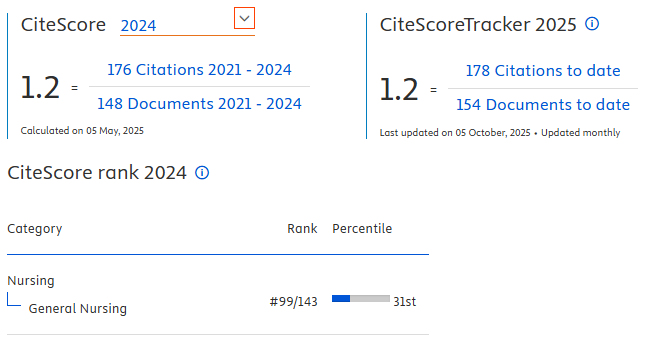Health Behaviors and Clinical Outcomes Among Patients with Myocardial Infarction in Indonesia
Downloads
Method: Sixty hospitalized MI patients participated in this descriptive correlational study. Data were analyzed using descriptive and correlational statistics.
Results: The majority of MI patients in this study had a moderate level of total health behaviors, exercise behaviors, dietary behaviors, and stress management. Interestingly, most of the patients had a high level of medication adherence, and smoking cessation. Also, their blood pressure (BP) and body mass index (BMI) of MI patients were at the normal level. In contrast, more than half the patients had a high level of fasting blood glucose and total cholesterol, and a low level of HDL. Moreover, nearly half of the patients presented a high level of LDL, and triglyceride. Exercise behaviors have a negative relationship with total cholesterol, and LDL. Interestingly, gender showed a positive relationship with total health behaviors, and smoking cessation. In addition, monthly incomes show a positive relationship with exercise behavior, and dietary behaviors. The number of times hospitalized appeared to have a positive relationship with systolic BP. Surprisingly, MI treatments showed a positive relationship with total health behaviors, smoking cessation, and BP.
Discussion: In conclusion, cardiac rehabilitation should involve health behaviors and clinical outcomes to prevent recurrent cardiac events and maintain health for MI patients.
Ahyana., 2013. The effect of self-efficacy enhancing cardiac rehabilitation program on health behaviors among patients with Myocardial Infarction in Aceh, Indonesia (Master's thesis). Prince of Songkla University, Thailand.
Ahyana., Kritpracha, C., & Thaniwattananon, P., 2014. Health behaviors among patients with myocardial infarction in Aceh, Indonesia. Songklanagarind Journal of Nursing, 34, 109-118.
Anand, S. S., Islam, S., Rosengren, A., Franzosi, M. G., Steyn, K., Yusufali, A. H., . . . Yusuf, S., 2008. Risk factors for myocardial infarction in women and men: insights from the interheart study. European Heart Journal, 29, 932-940. doi:10.1093/eurheartj/ehn018
Authors who publish with Jurnal Ners agree to the following terms:
- Authors transfer the Copyright and grant Jurnal Ners the right of first publication with the work simultaneously licensed under a Creative Commons Attribution 4.0 International License that allows others to remix, adapt and build upon the work with an acknowledgment of the work's authorship and of the initial publication in Jurnal Ners.
- Authors are permitted to copy and redistribute the journal's published version of the work (e.g., post it to an institutional repository or publish it in a book), with an acknowledgment of its initial publication in Jurnal Ners.
Jurnal Ners requires a formal written declaration and transfer of copyright from the author(s) for each article published. We, therefore, ask you to complete and return this form, retaining a copy for your own records. Your cooperation is essential and appreciated. Any delay will result in a delay in publication. The form can be downloaded HERE.
































